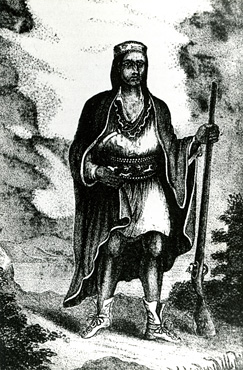first peoples
King Philip's War
The arrival of European colonists in North America uprooted native communities and decimated the native population. Though some of the native groups of the Connecticut River Valley established commercial exchange with the Europeans, relations soured as more and more settlers arrived and encroached further on the farming and hunting grounds of the indigenous people.
For almost sixty years before the war, the Wampanoags of southern New England lived in relative peace with the European settlers. An epidemic in 1616 devastated the Wampanoags, who then turned to the Europeans for protection against the rival Narragansetts. The Wampanoags taught the colonists about local food crops and farming techniques. The European population grew, claiming more of the Indians' crop and village land, while the Wampanoag population declined. By the late 1670s, the Wampanoags were treated as a subject people, and Metacomet began to organize a fight for the group's survival.
In the spring of 1675, Metacomet and his fighters launched a series of attacks against European villages, farms, and travelers across Massachusetts. Incited by Metacomet's successes, the Hadley sachem Wequogan began planning an attack on Springfield. In early October 1675, Wequogan and his warriors gathered on a palisaded hilltop near what is now the Springfield-Longmeadow line. Forewarned of the attack, townspeople sought refuge in several fortified houses, including John Pynchon's brick house. Pynchon was away with the militia in Hadley, and word of the attack came too late for the troops to make it back to Springfield.
The townspeople awoke to smoldering ruins. Most of the buildings in town had been burned, and the saw mill and grist mill were destroyed. Sporadic Indian attacks continued, and Springfield residents passed the winter in a state of siege. Provisions laid up in barns on the west side of the river provided food, but the work of repairing buildings and grinding grain had to be done by hand.
Nearly 600 Europeans died defending the Massachusetts colony, and nearly 8,000 Indians were killed, enslaved, or made refugees. Two musket shots killed Metacomet in 1677, leading the native warriors to surrender. Isolated fighting between the First Peoples of the Connecticut River Valley and European settlers continued for almost 100 years.
Today, the hilltop from which the attack on Springfield was launched in 1675 is known as King Philip's Stockade. There one can find picnic pavilions, an expansive view of the Connecticut River below, and a statue purportedly depicting the Windsor Indian who tried to warn the residents of Springfield.
